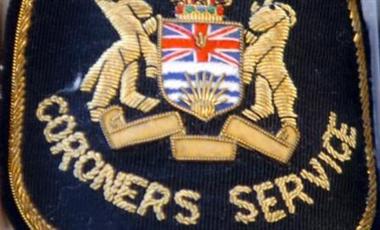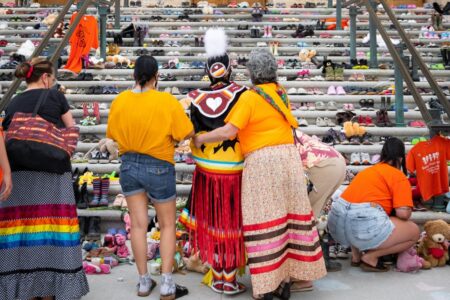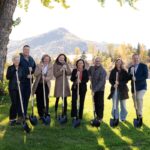New Trails Mapped Out For Rossland
Just as a wheel works better with spokes and a spider web works better before curious fingers or dog noses poke their centres out so too does a trail system work better when it is connected to the hub of the town. The spider web without a centre is a good example of Rossland’s current trail system. Hundreds of kilometres of excellent trails surround our mountainside city yet few of them penetrate into the core. Vital links are missing through town that would ideally connect one trail to another.
Imagine a Rossland with a network of trails interlaced throughout the neighbourhoods. Such a system would incorporate green space, pocket parks and unique geographical features providing commuting and recreational routes through town. Trails connecting schools to neighbourhoods, to the downtown core to other trails and on and on creating an outdoor network to match a community’s active outdoor personality can do a lot to bring a community together, and increase the overall experience in a town.
A perfect example of making trails work as part of an active transportation is the Resort Municipality of Whistler (This is not the ski area Whistler Blackcomb or Intrawest, rather the community of Whistler and its local government). Starting in the 70s, a series of progressive city councils in Whistler set in place the bylaws necessitating that all new developments on a formula system must create X meters of trail to add to the network or pay a fine into the trails account. Tough negotiations were also held with numerous property owners to achieve a paved multi-use trail system that runs through every neighbourhood in town, creating a pedestrian-friendly city that does not require a vehicle and encourages healthy lifestyles.
Rossland’s city planning department, in a series of proactive moves, has taken some creative steps in this direction over the past year.
“Selkirk College got in touch with us and were looking for a program that they could put a team of students on. They contacted us and said could we work in Rossland?” explained City Manager of Planning Mike Maturo, referring to the project’s genesis moment.
Thanks to Rossland’s mountain topography and its basic square grid street layout, streets that are occasionally interrupted by geography and are not continuous have left a number of undeveloped right of ways and alleyways that the city owns. Selkirk and the city sent out pairs of students; each were assigned sections of town to plot out the various undeveloped right of ways. One student captured all of the data in a GPS format. That information provided the platform for the city to apply for the BEAT (Built Environments and Active Transportation) grant which was ultimately used to complete the Active Transportation Study.
“We used that as our platform and said, ‘Yeah we’ve done a little work on this already can we qualify for this grant?’ So they threw us $22,000 and we went to tender, had two bids and we chose Stuart (Spooner) to undertake the funded study. He then took it to another step and did the study,” said Maturo.
BEAT was impressed with the study and report sent back in to them on completion of the project so much so that the Rossland contingent was invited to present the report as a model for other communities at their annual conference. No Rossland representatives were able to attend the conference due to scheduling conflicts, however.
Stuart Spooner, who also heads up the Kootenay Columbia Trails Society, took on the contract and spent September through December of 2008 working with the city and developing the Active Transportation Plan which he presented to council this past Monday evening (see attached document for the entire plan). The plan itself outlines the detailed process and methodology of the planning project which included a number of information gathering sessions with the public. 24 different routes ultimately made the cut and were mapped, costed, and outlined. Each was ranked as a high, medium or low priority.
“Because it hasn’t been planned for in the past, and because we’re on a mountainside and we’ve got a grid pattern of roads it was about identifying all of the public lands and remaining bits of green spaces and trying to link all of those together and come up with a bunch of routes that would encourage people to spend more time walking and riding. Most people in Rossland come and go from the downtown area. It was about identifying safe and attractive routes for people to do that.” said Spooner.
Spending good chunks of his time meandering through pockets of brush, greenery, alleyways and pieces of city owned right of ways, Spooner discovered many new nooks and crannies of Rossland.
“On a personal level, it was great getting to know my town a lot better. It gave me a good excuse to get out and poke around and find all of these little parts of the town that you don’t really ever come across. For example the area behind Ferraro’s there, there is a ravine and a banks and a bunch of really attractive little features in there. I’ve never been in there before and there is opportunities for trails and parkland but unless you live in those particular neighbourhoods you’re not necessarily aware of these areas but they are all places people would probably like to get out and explore,” said Spooner.
With the plan completed and presented to council, the next step in the process is council adopting the plan. Once adopted the real challenge begins in prioritizing the projects and sourcing funding to begin making them happen.
“Every one of those projects has a price tag so in some regards it boils down to money,” said Maturo. “How much is the city ready to dedicate once they prioritize the project? First council has to adopt the report at their next meeting. Let’s hope they adopt the report. Then it’s a matter of the city actually budgeting going forward having money set aside to either directly fund the projects piece by piece or as we’ve done it in the past to set money aside as matching grant money which is what we do normally,”
For the past several years the City of Rossland has set aside approximately 20 to 30 thousand dollars in an account to use in applying for matching grants where the grantor puts in an equal share of the cost.
“First council needs to prioritize the routes and then start finding grants to start funding them and tick them off one at a time,” said Maturo, adding, somewhat jokingly and somewhat seriously “Of course if we had some great philanthropists in town that wanted to donate some money to the project we could always do that too.”
Trails are not cheap and as noted by Councillor Jill Spearn during Spooner’s presentation to council this past Monday. “It’s great to see the actual costs on all of these projects. I didn’t realize the costs associated with trail building.”
The Centre Star Gulch trail, for example would cost $40,850. This trail would run approximately 1.5 km and connect the Centennial Trail with Columbia Avenue.
Having the detailed plans of the 24 routes along with costing of the project in place gives the city a great advantage in applying for and receiving grant funding as the projects are essentially ‘shovel ready’.
Possible sources of funding for trails may include the gas tax rebate the municipality receives each year. This is one among many options to be studied once the plan is adopted by council.
“This is stuff we need to explore once the plan is adopted to keep it going forward. Once it’s adopted we have our leverage tool and we can hopefully get more money for more of these projects” said Maturo
A perfect example of this plan in action is the Centre Starr Gulch Trail project. As one of the 24 trail recommendations in the Active Transportation plan the city used the data from the plan, applied for and received $22,000 from a Local-Motion matching grant to work on the project, identified as high priority in the plan.
According to Maturo, the trail would be a “major statement” as it would create an unbroken off-road trail linking Red Mountain with downtown Rossland. “We identified that trail as one that could work so we went to another grant source, Local Motion,” described Maturo. “One challenge is private property ownership along the way but we have a pretty good route all within city property with one little spot in the middle that we’re negotiating with a property owner on.”
Dealing with property ownership along the proposed trail routes will be a major challenge throughout the project. Spooner has been working with the Kootenay Columbia Trails Association on these issues for a number of years with great success in developing the KCTS trail network across largely private land giving him great insight into the issue.
“The biggest challenge I think is always going to be that people will support the idea in its concept and that it is for the common good but when it comes to having a trail next to your house there is that not-in-my-backyard situation that is the biggest challenge for people to put aside their instinctive reaction to go against change and think only in their own narrow perspective and embrace this as a good for the whole of the community,” added Spooner.
According to the City Planner, the negotiation process is going well with the property owner involved in the Centre Star Gulch Trail project and if everything works out the plan is to be in the ground developing the trail this summer. The city is under some pressure on the private property negotiations on this project as the grant money is already committed from the Local Motion grant and must be spent by the end of the summer as stipulated in the grant contract.
Beginning work on the project is also a project in future planning, as the goal is to preserve key properties or areas within the city, even if not immediately planned for a trail.
“In the past there has been some decisions made without a lot of forethought you know, that sold off, for example, the rail grade we used to have all the way through town,” said Spooner. “I think people realized that selling off a few cheap pieces of that was not such a good decision. Hopefully by identifying all of these routes we’re not going to just sell them off for a couple of bucks without thinking of the long term consequences.”
Ultimately, as the city funds and sources funding from grants and other donors to begin implementing the Active Transportation Plan, Rossland will be that spider web in repair with new strands of trail weaving the various neighbourhoods and amenities together. The ultimate goal is to become a trail-connected city that represents and fulfils the active outdoor lifestyle of Rossland residents and visitors alike.
“What we’re trying to do is make these short walks and connections more pleasant so more people will start to use the walkways we develop. There is special spot for pedestrians and it’s not on the shoulder of the road,” concluded Maturo.






















